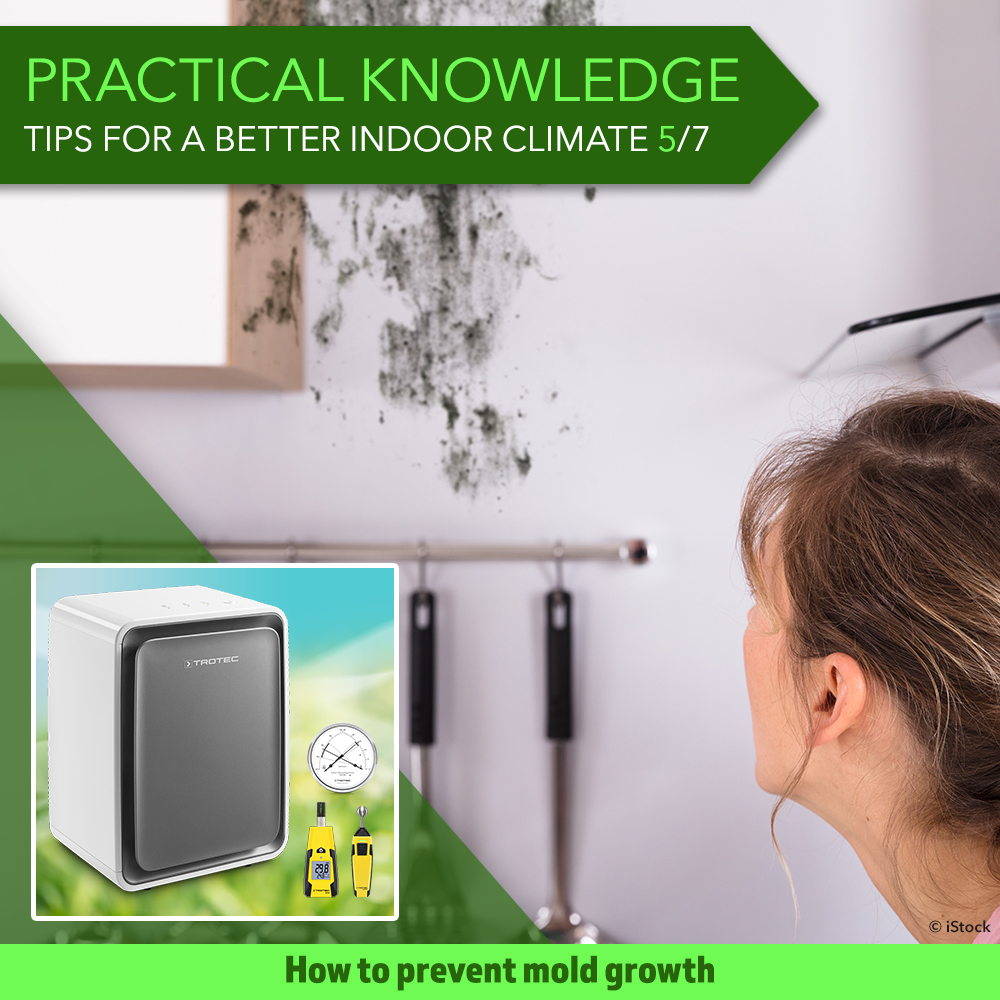 “Woahh, the air is thick in here!” Most of us will have heard this exclamation at some point – or exclaim it ourselves from time to time. For example, because of the smell of cooked food that lingers in our flats for hours despite leaving the windows open. Or because of chemicals evaporating, or the musty smell of mould. While most odours do not usually cause health problems, they can cause nausea. That’s why, in this practical knowledge series, we will give you the necessary tips to help you remove those pesky stinkers from your house and flat.
“Woahh, the air is thick in here!” Most of us will have heard this exclamation at some point – or exclaim it ourselves from time to time. For example, because of the smell of cooked food that lingers in our flats for hours despite leaving the windows open. Or because of chemicals evaporating, or the musty smell of mould. While most odours do not usually cause health problems, they can cause nausea. That’s why, in this practical knowledge series, we will give you the necessary tips to help you remove those pesky stinkers from your house and flat. Did you know that mould forms carcinogenic toxins and has long been identified as the cause of serious allergies? An insidious enemy, then, of whose existence within their own four walls many of those affected have no idea. Because mould often nests secretly without revealing itself immediately. In the early stages, for example it hardly smells and prefers to hide behind cupboards. This is why the search for the unwanted lodger does not begin until after the initial health issues have begun.
Did you know that mould forms carcinogenic toxins and has long been identified as the cause of serious allergies? An insidious enemy, then, of whose existence within their own four walls many of those affected have no idea. Because mould often nests secretly without revealing itself immediately. In the early stages, for example it hardly smells and prefers to hide behind cupboards. This is why the search for the unwanted lodger does not begin until after the initial health issues have begun. In the last part of our Trotec practical knowledge series we discussed the dangers of very low air humidity. But the opposite, very high humidity with values above 60 percent also poses considerable health risks. Because if too much humid air circulates in the apartment, the basic requirement for strong growth of health-threatening mould is fulfilled. Hidden in the farthest corner or behind cupboards, mould soon takes on a lively life of its own. But where does the excess moisture actually come from? And what is the most elegant way to get rid of the excess?
In the last part of our Trotec practical knowledge series we discussed the dangers of very low air humidity. But the opposite, very high humidity with values above 60 percent also poses considerable health risks. Because if too much humid air circulates in the apartment, the basic requirement for strong growth of health-threatening mould is fulfilled. Hidden in the farthest corner or behind cupboards, mould soon takes on a lively life of its own. But where does the excess moisture actually come from? And what is the most elegant way to get rid of the excess? In the last few weeks, winter has once again made us feel what ‘really cold’ means. Many people at home have turned the heating knobs all the way to the left – and are now suffering from the consequences of dry heating air. It dries out our mucous membranes, reduces their cleansing function and creates an ideal habitat for viruses. It also causes undesirable effects such dry nose and irritated eyes, as well as coughs, colds and sore throats. Because low humidity also increases the lifetime of infectious corona aerosols in the room air, there is virtually every reason to humidify the air as much as possible in the future.
In the last few weeks, winter has once again made us feel what ‘really cold’ means. Many people at home have turned the heating knobs all the way to the left – and are now suffering from the consequences of dry heating air. It dries out our mucous membranes, reduces their cleansing function and creates an ideal habitat for viruses. It also causes undesirable effects such dry nose and irritated eyes, as well as coughs, colds and sore throats. Because low humidity also increases the lifetime of infectious corona aerosols in the room air, there is virtually every reason to humidify the air as much as possible in the future. Rarely has there been so much talk about ‘ventilation’ as in the past and current year. No wonder, since the exchange of air in rooms was and still is considered a tried and tested means against potential corona virus load caused by infectious aerosols. So far, there is no measuring device that is able to prove the contamination of indoor air by SARS-CoV-2. However, it is possible to determine a necessary ventilation interval via the ‘detour’ of a permanent measurement of CO2 values. Because the more people are in living rooms, office spaces, production rooms, schools and daycare centres, the more the exhaled carbon dioxide level increases – to the point of a CO2 alarm: time to open all the windows!
Rarely has there been so much talk about ‘ventilation’ as in the past and current year. No wonder, since the exchange of air in rooms was and still is considered a tried and tested means against potential corona virus load caused by infectious aerosols. So far, there is no measuring device that is able to prove the contamination of indoor air by SARS-CoV-2. However, it is possible to determine a necessary ventilation interval via the ‘detour’ of a permanent measurement of CO2 values. Because the more people are in living rooms, office spaces, production rooms, schools and daycare centres, the more the exhaled carbon dioxide level increases – to the point of a CO2 alarm: time to open all the windows! We wish everyone a peaceful and wonderful Christmas!
We wish everyone a peaceful and wonderful Christmas! The dreaded second corona virus wave has arrived just in time for the beginning of the cold season. Since the start of the pandemic epidemiologists and virologists have been warning us of the effect winter can have, whereby the cold weather outside keeps people in their homes, spreading the virus more and more indoors in closed rooms. For example, after analysing contact tracing, a study by Japanese researchers found that people that people are 19 times more likely to become infected indoors than outdoors.
The dreaded second corona virus wave has arrived just in time for the beginning of the cold season. Since the start of the pandemic epidemiologists and virologists have been warning us of the effect winter can have, whereby the cold weather outside keeps people in their homes, spreading the virus more and more indoors in closed rooms. For example, after analysing contact tracing, a study by Japanese researchers found that people that people are 19 times more likely to become infected indoors than outdoors. Who had even heard of ‘aerosols’ a year ago? It is now clear that these long-living infectious particles floating in the air are responsible for the majority of Corona infections. The renowned aerosol specialist Prof. Dr. Alfred Wiedensohler from the Leibniz Institute for Tropospheric Research (TROPOS) in Leipzig warns that “in cold and temperate climates, the indoor climate is usually very dry during the heating season. This could promote the spread of coronaviruses”. This is because at higher air humidity, the droplets grow faster and fall to the ground earlier, and can therefore be inhaled less by healthy people.
Who had even heard of ‘aerosols’ a year ago? It is now clear that these long-living infectious particles floating in the air are responsible for the majority of Corona infections. The renowned aerosol specialist Prof. Dr. Alfred Wiedensohler from the Leibniz Institute for Tropospheric Research (TROPOS) in Leipzig warns that “in cold and temperate climates, the indoor climate is usually very dry during the heating season. This could promote the spread of coronaviruses”. This is because at higher air humidity, the droplets grow faster and fall to the ground earlier, and can therefore be inhaled less by healthy people. Patio owners are increasingly discovering that installing a warming infrared heating source there is worthwhile, especially during Corona. This is because it is safest to move celebrations with friends and extended family outside if possible, even during the colder months. But the question of which radiant model variant is the right one for you raises its head. Is it the space-saving wall or ceiling installation to heat a specific area? Or the mobile pedestal radiant heater that promises more flexibility, but also uses floor space?
Patio owners are increasingly discovering that installing a warming infrared heating source there is worthwhile, especially during Corona. This is because it is safest to move celebrations with friends and extended family outside if possible, even during the colder months. But the question of which radiant model variant is the right one for you raises its head. Is it the space-saving wall or ceiling installation to heat a specific area? Or the mobile pedestal radiant heater that promises more flexibility, but also uses floor space? Spending the evenings comfortably on your own patio is the new gold standard, especially during Corona. But because it is already getting noticeably cooler, you should winter-proof your patio paradise now – so that your nest outside will already be comfortably warm, even in the cold season. The modern infrared radiant heaters from Trotec will help you do this, and with their ‘warm’ support you can continue to enjoy your evenings on your patio. Find out in our Trotec guide series what distinguishes our radiant heaters, how they work and what you should consider when buying them.
Spending the evenings comfortably on your own patio is the new gold standard, especially during Corona. But because it is already getting noticeably cooler, you should winter-proof your patio paradise now – so that your nest outside will already be comfortably warm, even in the cold season. The modern infrared radiant heaters from Trotec will help you do this, and with their ‘warm’ support you can continue to enjoy your evenings on your patio. Find out in our Trotec guide series what distinguishes our radiant heaters, how they work and what you should consider when buying them.